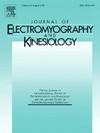Greater distal excitation of the biceps femoris long head reflects proximodistal differences in motor unit action potential properties
IF 2.3
4区 医学
Q3 NEUROSCIENCES
引用次数: 0
Abstract
Evidence on regional muscle excitation within hamstrings remains controversial, primarily because information derived solely from surface electromyograms (sEMG) amplitude does not necessarily provide an accurate estimate of neural drive to the muscle. To address this limitation, this study investigated whether there are proximodistal differences in motor unit properties of the biceps femoris long head during isometric hip extension and knee flexion tasks. Seventeen resistance-trained males performed isometric knee flexion and hip extension tasks at 20 % and 40 % of maximal voluntary contraction. High-density sEMG were recorded from proximal and distal regions of the biceps femoris long head and decomposed into individual motor units. Central motor unit and action potential properties were analyzed. Bipolar sEMG amplitude was also calculated for each region to simulate traditional sEMG measurements. Bipolar sEMG amplitude, motor unit action potential amplitude and conduction velocity were significantly greater in the distal region during both tasks. In contrast, no proximodistal differences were observed in central motor unit properties. These findings suggest that increased bipolar sEMG amplitude in the distal region of the biceps femoris long head is driven by motor unit action potential properties rather than differences in central modulation, likely influenced by intra-muscular variations in muscle mechanics and geometry.
股骨长头二头肌远端更大的兴奋反映了运动单位动作电位特性的近端和远端差异
腘绳肌区域肌肉兴奋的证据仍然存在争议,主要是因为仅从表面肌电图(sEMG)振幅获得的信息不一定能准确估计肌肉的神经驱动。为了解决这一局限性,本研究调查了在等距髋关节伸展和膝关节屈曲任务中,股二头肌长头的运动单元特性是否存在近端和远端差异。17名接受阻力训练的男性在20%和40%的最大自愿收缩时进行等距膝关节屈曲和髋关节伸展任务。从股骨二头长头近端和远端记录高密度肌电图,并将其分解为单个运动单元。分析了中枢运动单元和动作电位特性。还计算了每个区域的双极表面肌电信号振幅,以模拟传统的表面肌电信号测量。双极表面肌电信号振幅、运动单位动作电位振幅和传导速度在远端区均显著增大。相比之下,在中枢运动单元特性上没有观察到近端和远端差异。这些发现表明,在股二头肌长头远端区域增加的双极表面肌电信号振幅是由运动单元动作电位特性驱动的,而不是由中枢调节的差异驱动的,这可能受到肌肉力学和几何形状的肌肉内部变化的影响。
本文章由计算机程序翻译,如有差异,请以英文原文为准。
求助全文
约1分钟内获得全文
求助全文
来源期刊
CiteScore
4.70
自引率
8.00%
发文量
70
审稿时长
74 days
期刊介绍:
Journal of Electromyography & Kinesiology is the primary source for outstanding original articles on the study of human movement from muscle contraction via its motor units and sensory system to integrated motion through mechanical and electrical detection techniques.
As the official publication of the International Society of Electrophysiology and Kinesiology, the journal is dedicated to publishing the best work in all areas of electromyography and kinesiology, including: control of movement, muscle fatigue, muscle and nerve properties, joint biomechanics and electrical stimulation. Applications in rehabilitation, sports & exercise, motion analysis, ergonomics, alternative & complimentary medicine, measures of human performance and technical articles on electromyographic signal processing are welcome.

 求助内容:
求助内容: 应助结果提醒方式:
应助结果提醒方式:


